Movement
Training for Real-Life Fitness: Getting Fit for Daily Activities
Hey there, all you fit folks in their golden years!
It’s time to lace up those sneakers, grab your dumbbells, and get ready to dive into the exciting world of functional fitness. We all know that as we age, staying active and taking care of our bodies becomes more important than ever. But here’s the thing, staying fit doesn’t have to be a chore.
With functional fitness, we can make exercise a fun and lighthearted part of our daily routines while reaping the benefits of improved health, strength, and overall wellbeing.
So, what exactly is functional fitness?
In simple terms, it’s all about training our bodies to perform the activities of daily life with ease and grace. Think about it as preparing for the everyday challenges and adventures that come our way, whether it’s carrying groceries, playing with grandkids, or simply enjoying a leisurely walk in the park.
The secret sauce to functional fitness lies in focusing on movements that mimic those we encounter in our daily lives. We’re talking about squats, lunges, bending, reaching, twisting, and balancing exercises. The beauty of functional fitness is that it not only targets individual muscle groups but also improves our coordination, flexibility, and stability. It’s like giving our bodies a tune-up, ensuring that we can keep up with all the activities we love for years to come.
Let’s dive into some practical exercises you can incorporate into your workout routine.
Remember, it’s always a good idea to consult with your doctor or a certified fitness professional before starting any exercise program, especially if you have any pre-existing health conditions.
Squats with a Twist
Stand with feet shoulder-width apart, lower your body into a squat, and as you rise, twist your torso to one side, reaching your opposite arm towards the sky. Engage those abdominal muscles and repeat on the other side. This exercise helps improve lower body strength, mobility, and core stability.
The Farmer’s Walk
Grab a pair of dumbbells or a couple of heavy grocery bags. Walk briskly while maintaining an upright posture for a certain distance or time. This exercise works wonders for your grip strength, balance, and overall endurance.
Super Seated Leg Extensions
Sit on a stable chair and straighten one leg in front of you, hold for a few seconds, then lower it back down. Repeat on the other leg. This exercise targets your quadriceps, improves knee stability, and helps maintain strong leg muscles for getting in and out of chairs or climbing stairs with ease.
Stability Ball Push-Ups
Place your hands on a stability ball, keeping your body in a straight line. Lower your chest towards the ball, then push back up. This variation adds an extra challenge to regular push-ups by engaging your core for stability. Strong upper body muscles are essential for activities like carrying groceries or playing with your grandchildren.
Remember, it’s not just about exercise.
Nutrition plays a key role in aging gracefully too. Ensure you’re fueling your body with nutrient-rich foods like fruits, vegetables, lean proteins, and whole grains. Hydration is crucial too, so drink plenty of water throughout the day to keep your body running smoothly.
Let’s face it, aging is inevitable, but embracing functional fitness can make the journey a lot more enjoyable. So, put on your favorite workout playlist, grab a workout buddy, and let’s get that heart pumping.
Cheers to a life filled with vitality, strength, and a youthful spirit!
Disclaimer: Always consult a healthcare professional before starting any exercise program, especially if you have underlying health conditions or concerns related to exercise.

